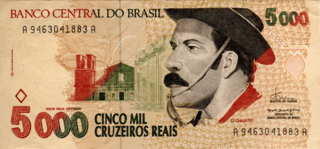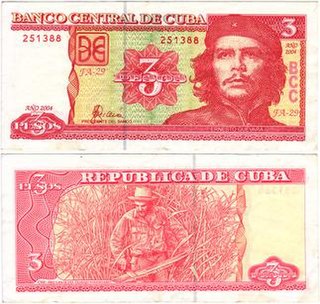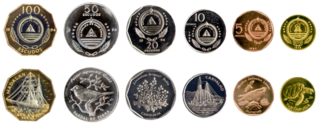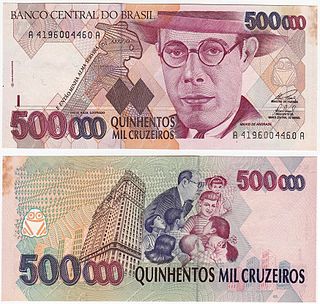
The Sucre was the currency of Ecuador between 1884 and 2000. Its ISO code was ECS and it was subdivided into 10 decimos and 100 centavos. The sucre was named after Latin American political leader Antonio José de Sucre. The currency was replaced by the United States dollar as a result of the 1998–99 financial crisis.
The centavo is a fractional monetary unit that represents one hundredth of a basic monetary unit in many countries around the world. The term comes from Latin centum, with the added suffix -avo ('portion').

The cruzeiro real was the short-lived currency of Brazil between August 1, 1993, and June 30, 1994. It was subdivided in 100 centavos; however, this subunit was used only for accounting purposes, and coins and banknotes worth 10 to 500 of the preceding cruzeiro remained valid and were used for the purpose of corresponding to centavos of the cruzeiro real, especially when the redenomination was carried out. The currency had the ISO 4217 code BRR.

The Cuban peso also known as moneda nacional, is the official currency of Cuba.
The boliviano is the currency of Bolivia. It is divided into 100 cents or centavos in Spanish. Boliviano was also the name of the currency of Bolivia between 1864 and 1963. From April 2018, the manager of the Central Bank of Bolivia, Pablo Ramos, announced the introduction of the new family of banknotes of the Plurinational State of Bolivia, started with the 10 Bs note, and then gradually arrived to introduce the 200 Bs note, presented in April 2019. The new family of banknotes of the Plurinational State received several awards such as "the best banknotes in Latin America", was highlighted by its security measures, its aesthetics and its inclusion of prominent figures in Bolivian history, being among those who awarded the "Latin American High Security Printing Press Conference".

The escudo is the currency of the Republic of Cape Verde. One escudo is subdivided into one hundred centavos.

The Brazilian currency has been renamed and redefined several times through its history. Since 1994, the official one is the Brazilian real (plural reais, with symbol R$ and ISO code BRL.

The real was the unit of currency of Portugal and the Portuguese Empire from around 1430 until 1911. It replaced the dinheiro at the rate of 1 real = 840 dinheiros and was itself replaced by the escudo at a rate of 1 escudo = 1000 réis. The escudo was further replaced by the euro at a rate of 1 euro = 200.482 escudos in 2002.
The austral was the currency of Argentina between June 15, 1985, and December 31, 1991. It was divided into 100 centavos. The symbol was an uppercase A with an extra horizontal line, (₳). This symbol appeared on all coins issued in this currency, to distinguish them from earlier currencies.
The peso was the currency of Paraguay between 1856 and 1944. It replaced the real at a rate of 8 reales = 1 peso. Until 1870, the peso was subdivided into 8 reales. Paraguay then decimalized, with 100 centésimos = 1 peso. The name of the subdivision was changed to centavo in 1874. The peso was replaced in 1944 by the guaraní at a rate of one hundred to one.

The escudo was the currency of São Tomé and Príncipe between 1914 and 1977. It was equivalent to the Portuguese escudo and subdivided into 100 centavos.

The escudo was the currency of Portuguese Timor between 1959 and 1976. It replaced the pataca at a rate of 5.6 escudos = 1 pataca and was equivalent to the Portuguese escudo. It was replaced by the Indonesian rupiah at an unknown exchange rate following East Timor's occupation by Indonesia. The escudo was subdivided into 100 centavos.

The escudo was the currency of Angola between 1914 and 1928 and again between 1958 and 1977. It was subdivided into 100 centavos with the macuta worth 5 centavos and was equivalent to the Portuguese escudo.
The angolar was the currency of Portuguese Angola between 1928 and 1958. It was subdivided into 100 centavos or 20 macutas. Angolar is Portuguese for "of Angola".
The peso was the currency of El Salvador between 1877 and 1919.

The Cruzado Novo was the short-lived currency of Brazil between 15 January 1989 and 15 March 1990. It replaced the cruzado in the rate of 1000 cruzados = 1 cruzado novo. It had the symbol and the ISO 4217 code BRN. In 1990, the cruzado novo was renamed the (third) cruzeiro. This currency was subdivided in 100 centavos.

The Brazilian real is the official currency of Brazil. It is subdivided into 100 centavos. The Central Bank of Brazil is the central bank and the issuing authority. The real replaced the cruzeiro real in 1994.

In 1986 because of inflation banknotes of the cruzado were issued by Central Bank of Brazil in denominations of 10, 50, 100, 500, 1000, 5000 and 10 000 cruzados. This bank had the sole authority to issue cruzado notes and Casa da Moeda do Brasil was the sole printer of these banknotes. Cruzado notes on the front/obverse featured prominent people while on the back/reverse depicted buildings and/or activities of those people mentioned before. Between 1989 and 1990 cruzado currency had also been replaced, this time by cruzado novo at a rate of 1 cruzado to 1000 cruzados novos.

The cruzeiro was the currency of Brazil between 1990 and 1993. It was the third iteration of a Brazilian currency named "cruzeiro", and replaced the cruzado novo at par. It was used until 1993, when it was replaced by the cruzeiro real at a rate of 1 cruzeiro real = 1000 cruzeiros.

The cruzeiro, initially denominated cruzeiro novo, was the currency of Brazil between 1967 and 1986. It is the second of the 3 historical Brazilian currencies called "cruzeiro".

















































